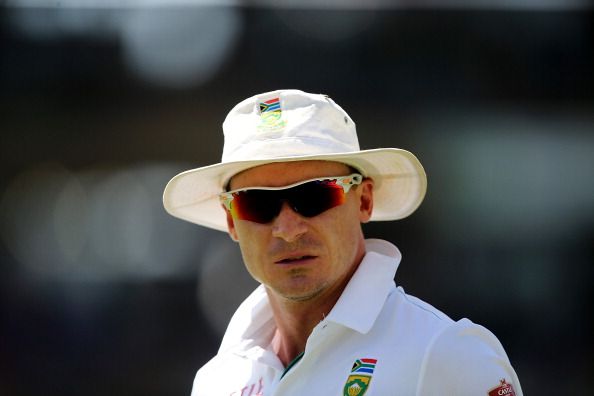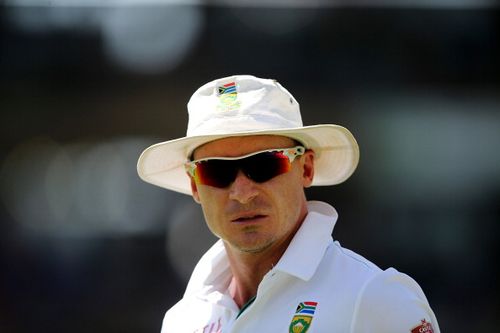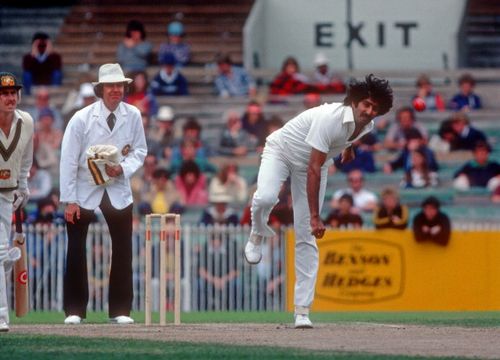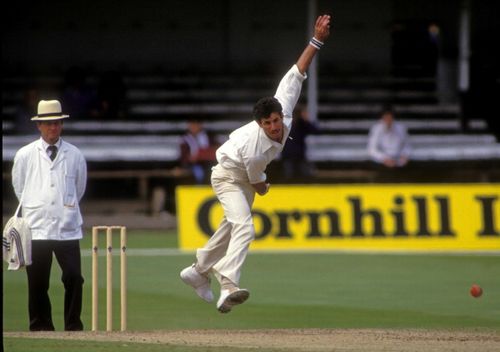
Is Dale Steyn the greatest fast bowler in Test cricket history?

In a recent analysis, augmented by statistics, I argued that Dale Steyn is perhaps a notch better than the West Indian fast bowling greats who enriched the game from the early 70s right through to the end of the 90s. While the inter-era comparisons made the verdict difficult, numbers hinted towards a fact that a very few would readily agree on: the speedster from South Africa is indeed a deadlier weapon than the likes of Andy Roberts, Michael Holding, Malcolm Marshall, Colin Croft, Joel Garner, Courtney Walsh and Curtly Ambrose.
So, the next logical step is to test whether Steyn can be anointed with the title ‘the greatest of all-time’, a study which has its own set of challenges. Firstly, one has to leave the pre-70s bowlers out of the picture for a couple of reasons: the playing conditions were extremely different from what they are today and there are far more contenders to compare with, all of them having different career spans.
To tackle the last problem, the variations in performance statistics, which have been brought about due to marginal changes in playing conditions, have been considered to be constant. In other words, the impacts of these changes in playing performance aren’t being factored in.
(Note: This context of this analysis is solely Test cricket)
The contenders
The first question that comes across is of deciding who all to include in the shortlist and who all to exclude. There are as many as twenty-one names who deserve a place in the shortlist by virtue of having 300 plus wickets in Test matches alone. However, for a more efficient comparison, the list had to be pruned down to nine names, including that of Steyn. The names being (in descending order of number of Test wickets):
| BOWLER | OVERALL FIGURES in Test Matches | |||||||
| Innings | Balls | Runs | Wickets | Average | SR | 5WI | Best | |
| Glenn McGrath (AUS) | 243 | 29248 | 12186 | 563 | 21.64 | 51.95 | 29 | 8/24 |
| Richard Hadlee (NZL) | 150 | 21918 | 9611 | 431 | 22.30 | 50.85 | 36 | 9/52 |
| Shaun Pollock (SAF) | 202 | 24353 | 9733 | 421 | 23.12 | 57.85 | 16 | 7/87 |
| Wasim Akram (PAK) | 181 | 22627 | 9779 | 414 | 23.62 | 54.65 | 25 | 7/119 |
| Dale Steyn (SAF) | 144 | 16109 | 8731 | 389 | 22.44 | 41.41 | 25 | 7/51 |
| Malcolm Marshall (WI) | 151 | 17584 | 7876 | 376 | 20.95 | 46.77 | 22 | 7/22 |
| Waqar Younis (PAK) | 154 | 16224 | 8788 | 373 | 23.56 | 43.50 | 22 | 7/76 |
| Imran Khan (PAK) | 142 | 19458 | 8258 | 362 | 22.81 | 53.75 | 23 | 8/58 |
| Denis Lillee (AUS) | 132 | 18467 | 8493 | 355 | 23.92 | 52.02 | 23 | 7/83 |
Some of the names missing out from this list are Courtney Walsh (519), Kapil Dev (434), Curtly Ambrose (405), Makhaya Ntini (390), Ian Botham (383), James Anderson (380) and Chaminda Vaas (355).
While Walsh and Ambrose were omitted because they were already compared to Steyn in the previous analysis, the rest missed out solely because they had bowling averages nearly touching the 30-mark. Malcolm Marshall was kept in this shortlist despite being there in the other analysis because he was the closest to matching Steyn on many fronts and merited a second look.
Initial observations
An immediate response after seeing the wicket-takers’ tally will be to announce that Steyn isn’t quite there, yet. After all, Glenn McGrath has an additional 170-odd wickets and a bowling average that is only a run below Steyn’s. But on a closer look, it is noticeable that Steyn has bowled in almost a hundred less innings than McGrath, but continues to have a far better strike-rate than the Australian. In fact, barring McGrath and Marshall, there’s isn’t anyone who is significantly better than Steyn when it comes to bowling averages.
A little bit of additional digging reveals that after 144 innings, McGrath had 351 wickets to his name – nearly 50 wickets lesser than what Steyn already has in the same number of innings bowled. While McGrath’s average was marginally better, Steyn is ahead in terms of strike-rate and the number of five-wicket hauls after the completion of 144 innings.
Performances home and away

Agreeing to the fact that Steyn does deserve a shot at being called the greatest, it is only fair to apply certain criteria to judge how he fared vis-a-vis the listed bowlers. The first litmus test for any bowler is to do as well in overseas conditions as he does at home, a feat that many have failed to achieve over the years.
| BOWLER | COMPARATIVE BOWLING PERFORMANCE in Test Matches (HOME & AWAY) | ||||||||
| Venue | Innings | Balls | Runs | Wickets | Average | SR | 5WI | Best | |
| Glenn McGrath (AUS) | In AUS | 131 | 15829 | 6483 | 289 | 22.43 | 54.77 | 11 | 8/24 |
| Away | 112 | 13419 | 5703 | 274 | 20.81 | 48.97 | 18 | 8/38 | |
| Richard Hadlee (NZL) | In NZL | 75 | 10663 | 4615 | 201 | 22.96 | 53.05 | 15 | 7/23 |
| Away | 75 | 11255 | 4996 | 230 | 21.72 | 48.93 | 21 | 9/52 | |
| Shaun Pollock (SAF) | In SAF | 109 | 12353 | 4955 | 235 | 21.09 | 52.57 | 9 | 6/30 |
| Away | 93 | 12000 | 4778 | 186 | 25.69 | 64.52 | 7 | 7/87 | |
| Wasim Akram (PAK) | In PAK | 70 | 7872 | 3423 | 154 | 22.23 | 51.12 | 8 | 6/48 |
| Away | 111 | 14755 | 6356 | 260 | 24.45 | 56.75 | 17 | 7/119 | |
| Dale Steyn (SAF) | In SAF | 80 | 8685 | 4665 | 220 | 21.20 | 39.48 | 15 | 6/8 |
| Away | 64 | 7424 | 4066 | 169 | 24.06 | 43.93 | 10 | 7/51 | |
| Malcolm Marshall (WI) | In WI | 58 | 6672 | 3150 | 157 | 20.06 | 42.50 | 8 | 7/80 |
| Away | 93 | 10912 | 4726 | 219 | 21.58 | 49.83 | 14 | 7/22 | |
| Waqar Younis (PAK) | In PAK | 60 | 6280 | 3288 | 162 | 20.30 | 38.77 | 11 | 7/76 |
| Away | 94 | 9944 | 5500 | 211 | 26.07 | 47.13 | 11 | 6/34 | |
| Imran Khan (PAK) | In PAK | 59 | 7673 | 3131 | 163 | 19.21 | 47.07 | 10 | 8/58 |
| Away | 83 | 11785 | 5127 | 199 | 25.76 | 59.22 | 13 | 7/40 | |
| Denis Lillee (AUS) | In AUS | 84 | 11534 | 5482 | 231 | 23.73 | 49.93 | 15 | 7/83 |
| Away | 48 | 6933 | 3011 | 124 | 24.28 | 55.91 | 8 | 7/89 | |
As visible, barring McGrath and Richard Hadlee, most bowlers have better performances while bowling at home as compared to bowling away. And to be fair to McGrath, he has had some good performances in England, New Zealand, and India, making him thoroughly deserving of this credit. But where he misses out is where Steyn gains: while McGrath has all the numbers supporting him, he hasn’t really taken quick wickets, something the team heavily depends on its prime fast bowler for.
On an average (with matches in England being an exception), McGrath has taken as many as eight overs for a dismissal when touring overseas. This is something that Steyn has achieved in just seven overs, with the number of deliveries needed to get a wicket improving while bowling at home – contrary to McGrath’s deterioration in performance when bowling in Australia.
McGrath’s better average can be attributed to the fact that he didn’t give away too many runs and tied down a batsman for a considerable period of time before dismissing him finally, whereas South Africa depended heavily on Steyn getting wickets quicker and in regular intervals or bursts.
Richard Hadlee’s away figures, impressive nonetheless, get skewed slightly due to his freakishly brilliant performance against minnows (back then) Sri Lanka, between 1984-1987, where he bagged 27 wickets at only 12 apiece.
In a continent that hates foreign pacers

Slow off the pitch. Low bounce. Quick deterioration of shine. Hot. Humid.
Asia is one of the most difficult places to bowl for a fast bowler. Had it not been for the trendsetter, Sarfraz Nawaz of Pakistan, many aspiring fast bowlers in the subcontinent would have been lost in the wilderness. The reverse swing, a potent tool developed by Sarfraz to utilize the old ball, provided a new lease of life to many subcontinent fast bowlers.
Over the years, Kapil Dev, Wasim Akram, Imran Khan and Waqar Younis, turned the old, scuffed up ball into a force to reckon with. But, unfortunately, this art has been largely restricted to players from the subcontinent, making it difficult for fast bowlers from outside Asia to bowl with the old ball.
Any bowler, Asian or otherwise, needs to succeed in the subcontinent to earn his stripes. Unlike the Duke and the Kookaburra, the SG cricket ball (widely used in the subcontinent) roughens up early and becomes difficult to bowl fast with after 20 odd overs. That’s when the expertise of the fast bowler with regards to the line and length and their command over reversing the old ball comes in.
| BOWLER | COMPARATIVE BOWLING PERFORMANCE in Test Matches (in ASIA & AWAY) | ||||||||
| Venue | Innings | Balls | Runs | Wickets | Average | SR | 5WI | Best | |
| Glenn McGrath (AUS) | In Asia | 36 | 3951 | 1658 | 72 | 23.03 | 54.88 | 1 | 5/66 |
| Away | 207 | 25297 | 10528 | 491 | 21.44 | 51.52 | 28 | 8/24 | |
| Richard Hadlee (NZL) | In Asia | 22 | 2909 | 1468 | 68 | 21.59 | 42.78 | 5 | 6/49 |
| Away | 128 | 19009 | 8143 | 363 | 22.43 | 52.37 | 31 | 9/52 | |
| Shaun Pollock (SAF) | In Asia | 31 | 3411 | 1391 | 60 | 23.18 | 56.85 | 2 | 6/78 |
| Away | 171 | 20942 | 8342 | 361 | 23.11 | 58.01 | 14 | 7/87 | |
| Wasim Akram (PAK) | In Asia | 102 | 11324 | 4867 | 216 | 22.53 | 52.43 | 11 | 6/48 |
| Away | 79 | 11303 | 4912 | 198 | 24.81 | 57.09 | 14 | 7/119 | |
| Dale Steyn (SAF) | In Asia | 31 | 3343 | 1902 | 84 | 22.64 | 39.80 | 5 | 7/51 |
| Away | 113 | 12766 | 6829 | 305 | 22.39 | 41.86 | 20 | 6/8 | |
| Malcolm Marshall (WI) | In Asia | 34 | 3461 | 1637 | 71 | 23.06 | 48.75 | 3 | 6/37 |
| Away | 117 | 14123 | 6239 | 305 | 20.46 | 46.30 | 19 | 7/22 | |
| Waqar Younis (PAK) | In Asia | 85 | 8220 | 4438 | 215 | 20.64 | 38.23 | 14 | 7/76 |
| Away | 69 | 8004 | 4350 | 158 | 27.53 | 50.66 | 8 | 6/78 | |
| Imran Khan (PAK) | In Asia | 80 | 10022 | 4158 | 205 | 20.28 | 48.89 | 12 | 8/58 |
| Away | 62 | 9436 | 4100 | 157 | 26.11 | 60.10 | 11 | 7/40 | |
| Denis Lillee (AUS) | In Asia | 6 | 792 | 410 | 6 | 68.33 | 132.00 | 0 | 3/114 |
| Away | 126 | 17675 | 8083 | 349 | 23.16 | 50.64 | 23 | 7/83 | |
Among the bowlers listed here, one can only marvel at the quality of pace bowling that the Pakistani trio of Waqar, Wasim and Imran Khan displayed in their heydays. And it’s only justified that they have the better figures while bowling in Asia. But one must observe how their bowling became less potent when they bowled outside the subcontinent, hinting at how subcontinental conditions overly suited their bowling performance.
Similarly, Hadlee’s good run against the Sri Lankans in Sri Lanka ensured that he is amongst the ones with the best bowling average in Asia. Shaun Pollock, despite being consistent, took more deliveries for each wicket than most of the rest, and Dennis Lillee had too small a sample size to be passed a judgment on. McGrath’s performance in the subcontinent improved only after 2001.
Steyn’s case, though, is remarkable. Though he is typecasted as a fiery bowler in helpful conditions, running in hard to make best use of the bounce and lateral movement, he is brilliant in the subcontinent, as well. He is the only player in the list to be as good in Asia as he is while bowling in friendlier territories. He is the fastest to get the wickets and has some memorable spells in Asia against some quality teams: 10/108 vs India (in Nagpur ‘10), 9/99 vs Sri Lanka (in Galle ‘14) and 8/114 vs India (in Ahmedabad ‘08).

The match-winner
What good is a fast bowler if he can’t win matches for his country. One might come across the odd fast bowler who keeps getting a steady flow of wickets but is unable to close matches for his country. And that is where this criterion has underlined importance. Many of the fast bowlers mentioned in the list have represented the champion teams of their era and have, at times, enjoyed the aura of invisibility around them that led to wickets being granted to their reputation. But it’s highly important to observe what impact those wickets have had on the outcome of the match.
| BOWLER | BOWLING PERFORMANCE in a WINNING CAUSE | |||||||
| Innings | Balls | Runs | Wickets | Average | SR | 5WI | Best | |
| Glenn McGrath (AUS) | 168 | 19780 | 7945 | 414 | 19.19 | 47.78 | 18 | 8/24 |
| Dale Steyn (SAF) | 82 | 8559 | 4364 | 275 | 15.87 | 31.12 | 21 | 7/51 |
| Malcolm Marshall (WI) | 86 | 9678 | 4264 | 254 | 16.79 | 38.10 | 17 | 7/22 |
| Shaun Pollock (SAF) | 97 | 10608 | 4081 | 223 | 18.30 | 47.57 | 9 | 6/30 |
| Waqar Younis (PAK) | 78 | 7771 | 4042 | 222 | 18.21 | 35.00 | 14 | 7/76 |
| Wasim Akram (PAK) | 81 | 8944 | 3901 | 211 | 18.49 | 42.39 | 13 | 7/119 |
| Denis Lillee (AUS) | 61 | 7923 | 3709 | 203 | 18.27 | 39.03 | 17 | 7/83 |
| Richard Hadlee (NZL) | 44 | 5808 | 2261 | 173 | 13.07 | 33.57 | 17 | 9/52 |
| Imran Khan (PAK) | 46 | 5941 | 2248 | 155 | 14.50 | 38.33 | 11 | 8/58 |
Like what was being hinted at throughout, Steyn is an out-and-out match-winner. In the 144 innings he has bowled in, he has been on the winning side in 82 innings – a whopping 57%. As far as the bowling average is concerned, only Hadlee and Imran Khan are better, with the latter being not very far off from Steyn. Sticking to his reputation, Steyn has been the fastest to take the wickets and nearly every one out of four innings of his has been a five-wicket haul.
Against the best
And finally, it is useful to see how the fast bowlers have fared against the best team of their respective playing careers. This is to measure the efficacy of the bowler when faced with the best opposition.
| BOWLER | BOWLING PERFORMANCE against MOST SUCCESSFUL TEAM OF PLAYING CAREER | ||||||||
| Innings | Balls | Runs | Wickets | Average | SR | 5WI | Best | Versus | |
| Denis Lillee (AUS) | 57 | 8516 | 3507 | 167 | 21.00 | 50.99 | 11 | 7/89 | England* |
| Imran Khan (PAK) | 29 | 3488 | 1695 | 80 | 21.19 | 43.60 | 6 | 7/80 | W. Indies |
| Richard Hadlee (NZL) | 19 | 2506 | 1124 | 51 | 22.04 | 49.14 | 4 | 6/50 | W. Indies |
| Malcolm Marshall (WI) | 36 | 4335 | 1959 | 87 | 22.52 | 49.83 | 7 | 5/29 | Australia* |
| Wasim Akram (PAK) | 21 | 2990 | 1288 | 50 | 25.76 | 59.80 | 4 | 6/62 | Australia |
| Dale Steyn (SAF) | 27 | 3164 | 1872 | 69 | 27.13 | 45.86 | 2 | 5/67 | Australia |
| Glenn McGrath (AUS) | 32 | 4082 | 1558 | 57 | 27.33 | 71.61 | 2 | 6/86 | S. Africa* |
| Waqar Younis (PAK) | 20 | 1883 | 1014 | 30 | 33.80 | 62.77 | 0 | 4/55 | Australia |
| Shaun Pollock (SAF) | 23 | 3232 | 1474 | 40 | 36.85 | 80.80 | 1 | 7/87 | Australia |
| Here, most successful implies team with maximum wins in that period | * = 2nd most successful team as player represented the most successful team of the period. | |||||||||
The South African pacer’s performances fall heavily on this front, faring at an average twenty-seven runs per wicket. His strike-rate, too, suffers and the five-wicket hauls are few and far between by his standards. One might also see McGrath endure a similar fate, even though he was a part of the most successful team of his generation.
Verdict
Yes, Dale Steyn is a terrific fast bowler. He takes wickets both in the subcontinent and in helpful conditions, with equal aplomb. He gets his dismissals in as few deliveries as possible. He contributes hugely towards the team’s victories and is better placed in this stage of his career than any of his predecessors were. However, while he might be better than the West Indies greats, one should reserve the judgment on him being the greatest of the modern game for a later date.
He is almost there, but not quite yet.